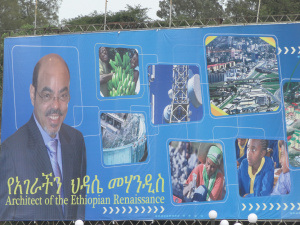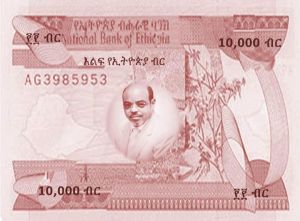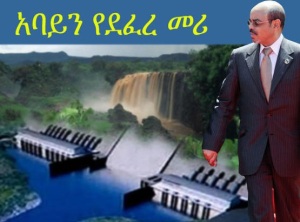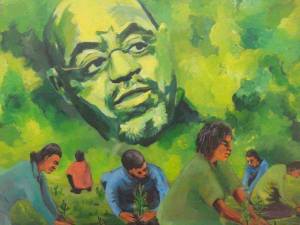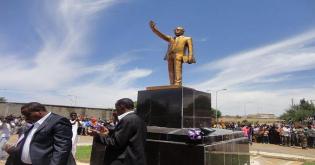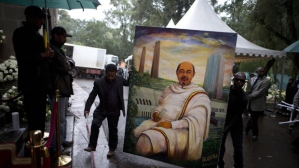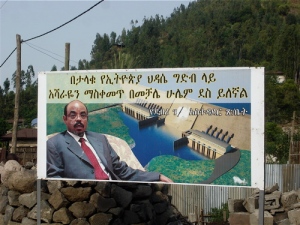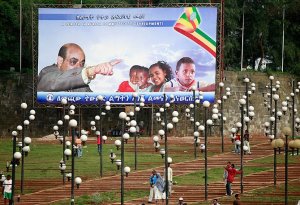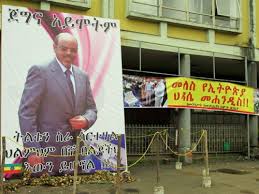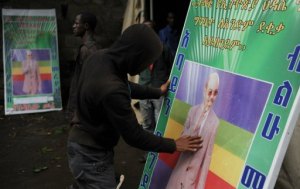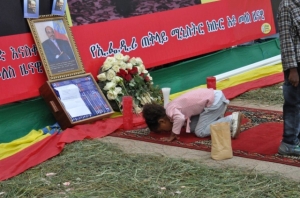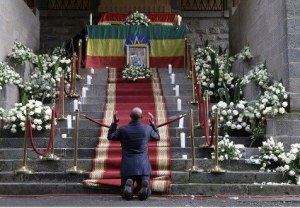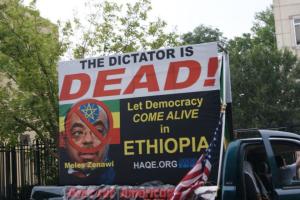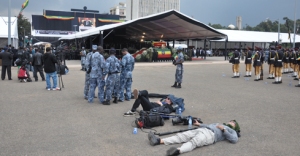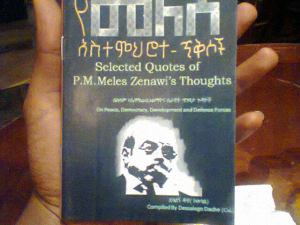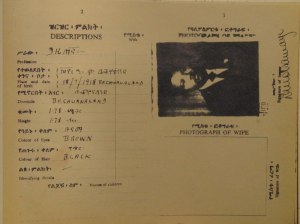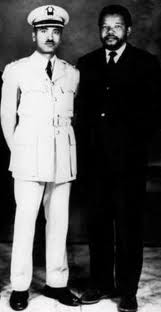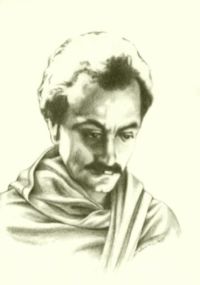Whilst you read about Ethiopian cuisines — especially those works wrote by foreigners — I bet you never folded to finish without noticing a mention of a traveler-adventurer called James Bruce. I mean Bruce’s new ‘discovery’ of Ethiopians as ‘raw meat-eaters’ and his exaggerated adventuring of being part of the Ethiopian ritual of raw meat feasting. This raw beef-eating culture — as reported by Bruce — shocked Europe. In the words of Jules Verne Bruce’s account “stirred a wholesale opposition” of disbelief so that he was named as ‘The Abyssinian Liar’. Dear Europe, you want to hear the truth? Bruce was right. Yes, Ethiopians EAT raw meat. How do you feel now?
Many wrote about this ‘weird’ Ethiopian cuisine and the legend behind it. Referring a chef, an Ethiopian-born-Swedish-raised chef Marcus Samuelsson, in his cookbook The Soul of a New Cuisine points out a popular legend re the story of Kitfo — one of the many popular types of raw meat dishes in Ethiopia — as:
Legend has it that kitfo […] came about during one of the many wars between the Christian Gurage and the Muslims, when the Gurages were hiding out in the mountains and needed to develop quick-cooking meals they could prepare without attracting attention from big, smoking fires.
Many writers reiterate this story and the legend behind it as a wartime tactic of deluding the enemy by drawing self as a cannibalistic monstrous creature — so that the enemy will get scared and surrender.
However, raw meat is not the only ‘creepy’ type of Ethiopian food. Eating animal testicle may surprise — if not shocked — many, but I’m a living witness growing eating sheep testicle. Even drinking animals’ blood appeared to be strange for many cultures, yet it’s also one more addition to our cuisine.
But, wait. What about eating human flesh? Mindful of the conservative Ethiopian culture and high religiosity, one may ask would Ethiopians eat human flesh or the leopard changes his spots? I am not sure about the latter, but in the former case, even if it was/is seldom, but, there’re some historical instances testified that human flesh as part of the Ethiopian dish, particularly, part of a famine time dish.
Scholars of different disciplines noted the major reasons behind cannibalism in various forms. Some claimed our morbid affection to our beloved one may make us cannibal and that triggers eating his/her flesh upon death. Others record killing enemies in a battle/brawl and eating its flesh as a sign of absolute dominance. Still, others assert cannibalism as part of traditional rituals and magical tricks. Among the many recorded — especially modern time — cannibalistic behaviors, most of them proved to be last breath cannibalism otherwise known as survival cannibalism.
In many famines ridden places — all over the world — a fellow human was served as an edible food as a coping mechanism. Timothy Snyder’s in his book The Bloodlands referring to an unknown Doctor from the 1930s aptly pointed the pros of this survival cannibalism:
Survival was a moral as well as a physical struggle. A woman doctor wrote to a friend in June 1933 that she had not yet become a cannibal, but was “not sure that I shall not be one by the time my letter reaches you.” The good people died first. Those who refused to steal or to prostitute themselves died. Those who gave food to others died. Those who refused to eat corpses died. Those who refused to kill their fellow man died. Parents who resisted cannibalism died before their children did.
In such dire situations, the lone survivors are those who dare to eat the salty fellow next to them — the cannibals.
In his article to the Slate, David Plotz asks why not eating a human corpse? Justifying his affirmative answer, David refers a one-time famine in Ethiopia:
A decade ago, I visited an Ethiopian village destroyed by famine, and I saw what is still the most horrifying thing I have ever seen: a 6-year-old boy named Saoudi—stick legs and arms, distended belly—whose lips and tongue were brown from eating dirt. It’s very likely that Saoudi didn’t survive the year, and if he did, he probably has permanent health and brain damage from the lack of nutrition. There were no corpses to eat in Dire Kiltu, but had there been, would it have been wrong—or even disgusting—for those villagers to have eaten them? To have fed their famished children protein and fat, rather than indigestible dirt and grass and shoe-leather, which is what starving people often eat?
David raised an important moral question, only he was wrong about the fact. David missed some testimonies from survival cannibals in Ethiopia — in different ages:
Recently, Discovery Channel in one of its reports mentions Ethiopia along with Russia as a famine time cannibal society. The following three accounts of survival cannibalism in Ethiopia are the glaring proofs of this fact.
The first story — Amharic — goes to the 17th century Harar:
በከብት ማለቅ የተነሳ (በሐረር ሕዝብ ላይ) ችጋር ጠናባቸው፡፡ ከዚህ በኋላ ገራድ እስላም ተሸመ፡፡ ኖሌ ላይ ብዙ ሰው በችጋር አለቀበት፡፡ ውሃም ቀጅ አልቀረ፡፡ ስለ ረሃቡ ፅናት አንድ ሴት ሰው አርዳ በላች፡፡ አንድ ሰው ነበረ በሐረር በየቀኑ ድሀ ይፈልግ ነበረ እያረደ ሊበላው፡፡ ረሃብ ስለመጥናቱ በአንድ ቀን ከሶስት ሰዎች ጋር ተቀምጠን የሰው ስጋ እያረደ የሚበላው ሰውየ መጥቶ ከደጃፍ ላይ ስጋውን በሸማው ቋጥሮ ቆመ፡፡ ›ስጋ ግዙ የፍየል ስጋ ነው› አለ፡፡ ከኛ ማህል አንዱ ሰው ›ይህ ነገር የሰው ስጋ መሰለኝ; ብሎ ጠረጠረ፤ ጠየቀውም፡፡ ቢጠይቀው ›አዎን› አለ፡፡ ከዚህ በኋላ ብዙ ሰው አለቀሰ፡፡››
‘YeHarer Tarik’ By: Unknown writer as Quoted by Getachew Haile
The second account is from the late 19th century Shewa, at the trying time of the four years ‘Great Famine’, from 1888 – 1892:
በዚያን ዘመን ደግሞ በሸዋ እንሳሮ ከሚባል አገር አንዲት ሴት ሰባት ልጆች በልታ ተይዛ ከአፄ ምኒልክ አደባባይ መጣች ንጉሱም እንጦጦ ከእልፍኙ ደጃፍ ተቀምጦ መረመራት እርሷም ‹አዎን ቢርበኝ በላኋቸው› አለች፡፡ እርሷ ግን እንኳን ሰባት ሰው የበላች ቅናሽ ስጋ የቀመሰች አትመስልም ነበር፡፡ አንጀቱዋ ከጀርባዋ ተለጥቆ እጇን እግሯን ማዳት ወርሷት ትንሽ ደኮ ለትባ ታሳዝን ነበር፡፡ ንጉሱም ‹እንዴት አገሬ ጠፋ፣ ደኸየ፤ ዘመዴ አለቀ› ብሎ አዘነ፡፡ እንያም ይዘው ያመጡት ባላጋሮቹ ‹የርሷን ልጅ ትታ የኛን ልጅ ለይታ ከበላች ፍርድ በቃ ይስጡን፤ መሞት ይገባታል› አሉ፡፡ አፄ ምኒልክም ‹ለኔ ስትሉ ተውልኝ፤ ቢጨንቃት ቢርባት ነው፤ ደግሞ ሌላ ልጅ ካላጣኹ ብላ ነው እንጅ ከባሰባት ልጆቿንም ቢሆን አትተውም ማሩልኝ› ብሎ አሰማራት፡፡ ወዲያው ልብሱን ቀለቤዋን ዳርጎ እርሷን ማድ ቤት፤ ልጇን ተማሪ ቤት አገባቸው፡፡
‘YeGojam Tarik’ By: Alqa Tekleyesus Wakijira
From the same period another eyewitness’ testimony goes:
‹አንዲት ልጅ ወዛ ብላለች ጋይንቲ ደስታ የሚባል ሰው ነበርና እሱ እየረዳት ተነስታ ፍል ውሃ ወረደች፡፡ ብዙ ሰው የተቀመጠው እዚያ ነው፡፡ ይህ ስደተኛው ሁሉ ተቀበለና እዚያ አረደና በላት፡፡ ልጆቻቸውን ጥቃቅኖቹን እያረዱ የበሉ ብዙ ናቸው፡፡››
‘Metshafe Tizita ze Aleqa Lema Hailu‘ By: Mengistu Lema
These are only the recorded accounts. We can imagine the many untold similar incidents. The one thing that such incidents testified is that there’s nothing as trying times — on the long spectrum of morality — that defines vice and virtue.
One of the most enjoyable moments surfing the Internet is bumping with the numerous self-help ‘how to …’ guides. From that point of view, Internet users are divided into two contrasting categories: those who write/talk/illustrate how to …’ and those who read/listen/watch ‘how to …”. In other words, everybody is the master of everyone and everyone is a pupil of everybody. You’d get some of the guides creepy as How to make your own vagina or How to become a vampire or How to make a Ph.D. Diploma and so forth. Endless guides. Myriad ideas.
Hereby, I’m doing the ‘how to create your own religion’ stuff — using exclusively Ethiopian traditional and modern materials. Googling tips and tricks on creating your own religion is a mayhem work. There’re a lot of them. You can’t afford all you got. The very purpose of this blog is simplifying these daunting task. Putting all the resources in one place in a very illustrated fashion.
Five steps. One grand religion. A multitude of followers. All that you need is a dead tyrant.
Fortunately, one ruthless tyrant kicked the bucket on July or August 2012. They said the only good tyrant is a dead one. True. He’s an angel. Let’s descend to the steps one by one. Please, be cautious of not missing and mingling the steps. If you missteps or interlace the steps, the writer is not responsible for the results.
Step one: Creation
In the beginning, man created god! Create your own god. According to a recent data over 96 percent of Ethiopians believe in the God of Abraham or they or they subscribe one of the three Abrahamic middle eastern products — Christianity, Islam, or Judaism. Let’s deviate from this imported-mainstream-freemium subscription and take the premium version — create your own god. Call him/her/their ‘MZ‘. Great. You came half to the first steps. Felt good already? Let’s finish the creation and naming by adjectivizing it. I can provide you some from my archives. (you can use all for free but except the ™ed):
ተወርዋሪ ኮከብ፣ ጀግና ፣ ደፋር፣ ህያው፣ ፍቅር፣ የአፍሪካ አለኝታ™፣ የዓለም ብርሃን፣ የድሃ መከታ፣ የመሪዎች መሪ፣ እንባ አባሽ፣ የወጣቱ አለኝታ፣ የኢትዮጵያ አይን ብሌን፣ አዋቂ፣ የመጠቀ፣ ታላቅ፣ የህዝቡ አጉራሽ፣ ባለራዕይ፣ ባለዓላማ፣ ታጋይ፣ ክቡር ፣ የረቀቀ™፣ ሳይንቲስት፣ ቅን፣ ደግ፣ የልማት ፊትአውራሪ፣ የጦር ሜዳ አናፂ፣ መሀንዲስ፣ ሰላማዊ፣ ዲሞክራሲያዊ፣ ባለብሩህ አዕምሮ፣ እረፍት የለሹ፣ ገበሬው፣ ባለአዝመራው፣ ዘላለማዊ፣ ድንቅ፣ መብረቁ፣ የቁርጥ ቀን ልጅ፣ አልባሽ – አጉራሽ፣ ለጠላቶቹ ሳይቀር ደግ የሚመኝ፣ ባለ ግርማ ሞገስ፣ የማይነቀስ- የማይወቀስ™፣ የድህነትን ገዳይ፣ የዲሞክራሲ አዋላጅ™፣ ቆራጥ፣ አስተዋይ፣ ምክንያታዊ፣ የቀለም ቀንድ፣ መፅሃፍ ትራሱ፣ እንቅልፍ ለምኔ፣ እረፍት አልባ፣ ሳተና፣ እውነታን ፈላጊ፣ ስትራቴጂ ቀያሽ፣ ሊቀ-ሊቃውንት፣ የሰላም አምባሳደር…
Whatever you want. Take care of plagiarism. For those of you who’re visual learners, the following picturized adjectives could be a little help:
Step Two: Immortalization
Gods are immortal. So do your god be. Once you’re done with the creation, the next step is immortalization. Immortalization is the most important step that differs humans with gods. Immortalization requires propaganda, intellect, and deceitfulness. You should be a minstrel who is able to say:
‹መለስ ዜናዊ› ታላቅ መስፍን፣ ነበሩ ሲሉ ባገራችን፣ እንዲያ ሳያጡ ሰገነት፣ ምነው አደሩ ፈረስ ቤት፣ ሞከሩት እንጂ አልኖሩም፣ ከዳሞት አልቀሩም፡፡››
As well as a polyglot bard, who’s able to say rhymes over rhymes as:
‹‹ለአዳም ዐባይ ሀበሀገሩ ገነት መለስ አዶናይ፤ በከመሜጦ መቅድም ምስለ ሰራዊት መካልይ፤ ኃበ ብዙኃን ሜጦ ለመናኔ ዓለም ግዕዝ መስፍነ ዓለም ነብይ፡፡›› ትርጉም፡ ‹‹አዶናይ መለስ ዓዳም ዐባይን ወደሀገሩ ገነት፤ ከሠራዊቶቼ ጋር አስቀድሞ እንደመለሰው የዓለም ገዥ ነብይ ዓለምን የናቀግዕዝን ወደ ብዙዎቹ መለሰው፡፡››
Further beyond the stanzas, there’s a monument. Monumentalization of your not yet famous god is another tool of immortalizing it. You may take a lesson or two from the following instances:
Step 3: Ubiquity
Once you anoint the mass immortalizing your god, don’t forget to put it everywhere. If a god is not omnipresent, that’s a god who deserves to perish. You know what? The mass is amnesiac — which forgets things easily. The one essential tool to tackle this syndrome is the ubiquitousness of your recently created — reread step one — God. Make it everywhere and anywhere possible, so that it becomes impossible not to notice its presence. Yours truly got some illustrations:
Step 4: Declaration
Now, your God is immortal stuck in the public’s memory. Please, organize a little inaugural party and declare your religion. Congratulations for successfully creating your own religion. You may prepare a presser titling: “I am a born-again believer and my religion is MZ“.
Remember to introduce the shrine, the way of worshiping and the manner of prayer. I mean like this:
Step 5: Let there be multitudes of enemies
Finally, mastering the invention enemies. After all, virtue is not a virtue without the existence of vice. Goodness is the kind sister of badness. Darkness the state of non-light. To resonate down into the congregation, your god needs an adversary. A fierce-blasphemy-spitting filthy adversary, who celebrate and mock the importance of the death of your god:
This’s it. You create your own god in a few minutes and from now on it’s unto you to collect tithe in the name of your compassionate god or to ‘heal’ every kind of malady that your god created in the first place. Is that not funny? It maybe, but that’s what they called entrepreneurship.
P.S.
One important thing is missed here — a holy scripture. You need to have a book, which compiles what your god is all about and the do’s and don’t’s:
ረኃብ ካለ ርኁብ አለ! የኪዳነ ወልድ ክፍሌው ‹መፅሃፈ ሰዋሰው ወግስ፤ ወመዝገበ ቃላት ሐዲስ› ደግሞ ረኃብን ‹የምግብ እጦት፤ ቀጦና፤ ችጋር› ብሎ ሲፈታው፤ ‹ርኁብ›ን ደግሞ ፡ ‹የተራበ የተቸገረ፤ ራብተኛ፤ ራብ የያዘው ምግብ ያረገዘው› በማለት ይተረጉመዋል፡፡ በርግጥ በዚህ ፍች ረኃብ (Hunger) እና ችጋር (Famine) አንድ ላይ ተደባልቀው ተቀምጠዋል፤ አንድ ባይሆኑም፡፡
በዚህች አጭር ጦማር ‹ራብ የያዘው ምግብ ያረገዘው› ኢትዮጵያዊ በረኃብ ጊዜ ከጭንቀቱ እና ግራ ከመጋባቱ ብዛት በዙሪያው ያሉ ነገሮችን ሁለ ጨርሶ ይጠብቀኛል ይወደኛል ብሎ ለሚያስበው ፈጣሪ ያቀረበውን ልመና / ቁጣና ስድብ / ትችት ለማየት ነው የታሰበው፡፡ ከዛ በተረፈ ኢትዮጵያና ረኃብ፤ የረኃብ ፖለቲካ፣ የረኃብ መነሻና መድረሻ የሚሉ ሀሳቦችን ብዙ ፀሃፊዎች በየጊዜው የዳሰሷቸው ጉዳዮች እንደመሆናቸው የዚህ ጦማር አካል አልሆኑም፡፡
ሰው በረኃብ ወቅት የልቡን አውጥቶ መናገሩ እውነት ነው፡፡ ስለእንጀራ ሲል ሰው ብዙ ነገር ያልፋል፡፡ እንዲህ እስኪባል፡
‹‹እዛ ወንዝ ማዶ፣ እንጀራ አለ ብለው አይነግሩም ለድሃ፤
በቀን በሌት ብሎ፣ አቆራርጦት ያድራል አርባራቱን ውሃ፡፡››
ሰው በመከራ ጊዜ አጋዤ ይሆናል ብሎ ከጎኑ ይዞት የሚኖረውን አምላክ ‹ወዲያ በል› እስከ ማለት ይደርሳል፡፡ አይሆዶች በሁለተኛው የዓለም ጦርነት ወቅት የደረሰባቸውን ጭፍጨፋ ከአምላካቸው ብዙ ቢያራርቃቸው፤ አንድ ያልታወቀ አይሁድ በMauthausen Concentration Camp ግድግዳ ላይ እንዲህ አለ፡
“If there is a God, He will have to beg my forgiveness“
የ1994ቱ (እ.ኤ.አ) የሩዋንዳ የዘር ማጥፋት ወንጀል ብዙ ሩዋንዳዊያንን አለ የሚሉትን አምላካቸውን ጥርጣሬ ውስጥ እንደከተተው የቅርብ መረጃዎች ያሳዩናል፡፡
ኢትዮጵያዊያንስ? በኢትዮጵያ ታሪክ ከተስፋ አስቆራጭ ጊዜያት ዋነኛው የረኃብ ጊዜ ነው፡፡ ከተስፋ መቁረጡ የተነሳ ኢትዮጵያዊያን በረኃብ ጊዜ በአምላካቸው ላይ ማመፃቸው አልቀረም፡፡ እኔም በረኃብ ወቅት ኢትዮጵያዊያን ‹ይጠብቀናል› ለሚሉት አምላካቸው ከልመና እሰከ ቁጣ የገለፁባቸውን ስንኞች አሰባሰብኳቸው፡፡
ልመና
‹‹እባክህ አምላኬ፤ አዝመራውን ባርከው፣ ሆዴ ሊቀደድ ነው፤ እየራበኝ ሳከው፡፡››
***
‹‹ውሃ እንደተጠማኹ፣ እንጀራ እንደራበኝ፤
ጭራሹን ሳላየው፣ እግዜር ባልገደለኝ፡፡››
***
‹‹እባክህ አምላኬ፤ ነፋሱን መልሰው፤
ወንድም ወንድሙን ፤ ሸጦ ሳይጨርሰው፡፡››
***
‹‹እግዜር ባንድ ነገር፣ አይጠረጠረም፤ ድሀ ድሀው ሞቶ፣ ባለጠጋ አይቀርም፡፡››
***
‹‹አሻቅቤ ባየው፤ ሰማዩ ቀለለኝ፣
አንተንም ሰፈራ፤ ወሰዱህ መሰለኝ፡፡››
***
‹‹ኢትዮጵያ እጆቿን ወደ ምግብ ትዘረጋለች!››
‹‹ትችለናለህ ወይ፣ እግዜር በትግያ፤
ከብቱን ብትገልብን፣ ጠመድን ባህያ፡፡››
***
‹‹የእኛ እግዜር ምቶ፣ የእነሱ ቆመና፤
ውሻ ‹ቻዝ› እያሉ፤ አሽበላለጡብን አንኮላና ቁና፡፡››
***
‹‹ግራዝማች ደንጎሎ፣ ፊታውራሪ ጎመን እግዜርን አከሉ፤ አፍንጫን አቃንተው፣ መልክ አስተካከሉ፡፡››
***
‹‹ከኢትዮጵያ ጸሎት፤ ጣሊያኖች በለጡ፣
በአርባ ዘመናቸው፤ ክንፍ አውጥተው መጡ፣
ፈጣሪ ተጠንቀቅ፤ ወዳንተም እንዳይመጡ፡፡››
***
እግዜርን ግሳፄ
‹‹እግዜር ምድር ወርዶ፣ ጉዱን ነግሬው፤
የደላኝ መስሎታል፣ ተመስገን ብለው፡፡››
***
‹‹ዝናቡ የልህ የልህ፤ ጠሀዩ የልህ የልህ፤ እባክህ አምላኬ፣ እንዴት ልሁንልህ፤ ትዘራው እንደሆን፣ ቅብቅቡ ያውልህ፡፡››
***
‹‹እዚያ ላይ ተቀምጠህ፤ ስታላግጥ በሰው፣
እናትህ ነደደች፤ ሀዘንን ቅመሰው!››
***
‹‹ውጭ ሀገር ይመኛል፣ ዋ ሀበሻ ሞኙ፤
እዚያ እግዜር የለም ወይ፣ እዚህ የሚያውቀኙ፡፡››
***
‹‹ተጣልቻለሁ ካምላክ ጋራ፣ በሌላም አይደል ባንድ እንጀራ፤ ከለከልከኝ ምነው፣ ሆድ የለህ አትበላው::››
***
‹‹እግዜር እታች ወርዶ፣ እኔ ላይ ወትቼ ስፍራ ብቀይረው፣
ያውቃታል ስራውን፣ ቅዱስ ሚካኤልን ሰውም አላረገው::››
***
‹‹ምን ገደለው – ውጋት፤
ምን ገደለው – ቁርጠት፤
እግዜር ምን ቸገረው፣ አይማኸኝበት፡፡››
***
‹‹ዘጠኝ ታድናለህ፣ አንድ ትገድላለህ፤
የሴት ልጅ ነህና፣ ምን ፍርድ ታውቃለኸ፡፡››
***
‹‹ከሰራኸው ስራ፣ ሁሉም ተበላልህ፤ እሬት በመምረሩ፣ ድንጋይ በጥጣሬው ሁለቱ ቀረልህ፡፡››
***
‹‹እግዜርም እንደሰው፤ በሀሰት እየማለ፣
አንድ እንጀራ ብለው፤ ሙት የለኝም አለ፡፡››
***
‹‹እፋረደዋለሁ፣ አልለቀው በዋዛ
ከምድር ላይ ሲያጠፋ፣ የሰውን ልጅ ለዛ፡፡››
***
‹‹የኔ መሪጌታ፤ እርስዎማ ምን ይሉ፣
የኔ መሪጌታ ፤ እርስዎ ምን ይበሉ፣
እሱ እየገደል፤ ተዝካሩን ሲበሉ፡፡››
***
ምንጭ:
ዶ/ር ፈቃደ አዘዘ: ‹ሰሚ ያጡ ድምፆች› ፣ ቦጋለ ተፈሪ: ‹ትንቢተ ሼህ ሑሴን ጅብሪል› ፣ የሕዝብ
In this short blog post I’ll try to shade a light on the works of Zera Yaqob, the Philosopher and his dispel, Welde Hiwot as well some of the selected commentaries on their works. Disclaimer suggests no detailed analysis of their work is implied and if you’re one looking for it, you may have to look some other place.
It’s true that there was/is a debate over the identity — even their existence — of these two philosophers. There are some Eurocentric scholars like Carlo Conti Rossini, who doubt the existence of a seventeenth-century philosopher called Zera Yaqob and boldly remarks:
Zar’a Ya’aqob is not Ethiopian or there was no such philosopher called Zar’a Ya’aqob. The one known as Zara Ya’aqob was a pseudonym used by a 19th Century Freemason European — who penned the treatises as better known as the Hatetas.
Yet again in recent times, some Ethiopians reiterate this conclusion from a totally different perspective. However, from the Hatetas themselves to scholars who studied them in detail, we’ve got an enormous scholarship that ascertains Zera Yaqob’s citizenry — Ethiopian.
Whatever.
The squabbles aside, this post is all about introducing the Hatetas to a novice. Reading the Hatetas kicks us to see the resemblance of Zara Yaqob-Wolde Hiwot duo as something akin to with the Socrates-Plato duo — a master-pupil relationship. That’s why Welde Hiwot’s treatise feels akin as a sequel to Zera Yaqob’s grand treatise.
When we jump to the biography of the master and the pupil, the opening lines of Hateta Zar’a Yaaqob began by introducing the writer’s himself:
I was born in the land of the priests of Aksum. But I am the son of a poor farmer in the district of Aksum; the day of my birth is 25th of Nahase 1592 A. D., the third year of the year of [King] Yaquob. By Christian baptism I was named Zar’a Ya’aqob, but people called me Warqye.
Contrarily, there’s no such autobiographical introduction on Welde Hiwot’s treatise. Some delve into his life and suggest ‘Melaku’ as Walde Hiwot’s pre-baptismal name. On a different point, though, the treatise of Welde Hiwot is much longer, detailed, parable-filled and allegorical, scholars seems interested in the work of Zara Yaqob. Mathias Victorien Ntep aptly remarked the status of Zara Yaqob in the world philosophy as:
If the Frenchman René Descartes is regarded as the pioneer of “Modern Philosophy”, if many believe that Kant – the philosopher who borrowed the concept of the “Thing in itself” or “Noumenon” from Amo, the philosopher of Guinea in Africa – is the “greatest philosopher” of the “European Enlightenment”, then all those who´re hep to and familiar with the treatises of Zera Yacob or Zar´a Ja´aqob would argue with me that the works of this East African philosopher represent the climax of both “Modern Philosophy” and the “Age of Enlightenment.
Amplifying the above assertion, Ethiopian philosopher, Tedros Kiros enunciate that:
Zar’a Ya’aqob is the founder of rationality in Africa. He was a contemporary of Rene Descartes, the founder of rationality in France.
Yet again Claude Sumner, ‘a Canadian by birth an Ethiopian by choice’, Philosopher takes the praise to Zara Yaqob to a new level as:
Modern Philosophy, in the sense of a personal rationalistic critical investigation, began in Ethiopia with Zär´a Ya´aqob at the same time as in England and in France.
Hereinbelow are the treatises of Zera Yaqob and Welde Hiwot in different languages and selected commentaries/critiques on the treatises — all the hyperlinked are downloadable.
Hateta Zera Yaqob
Ge’ez, original
Amharic 1, translated by Zemenfes Kidus Abraha, 1955
Amharic 2 translated by Getachew Haile, 2014
English, translated by Claude Sumner
Hateta Walda Heywat
Ge’ez, original
English, translated by Claude Sumner
Critiques and commentaries on the Hatetas — by Claude Sumner
Introduction to the Treatise of Zar’a Ya’aqob and Walda Heywat
Ethiopian Philosophy, vol. II: The Treatise of Zera Yaqob and Welde Hiwot: Text and Authorship
Ethiopian Philosophy, vol. III: The Treatise of Zera Yaqob and Welde Hiwot: An Analysis
Classical Ethiopian Philosophy
The Light and the Shadow: Zera Yacob and Walda Heywat: Two Ethiopian Philosophers of the Seventeenth Century, Page 172 -182
Critiques and commentaries on the Hatetas — by Tedros Kiros
Zera Yacob and Traditional Ethiopian Philosophy Page 183-191
The Meditations of Zara Yaquob
Zara Yacob: Rationality of the Human Heart
Seventeenth century Rationalist: On the rationality of the heart
Critiques and commentaries on the Hatetas — by different scholars
The Ethics of Zär’a Ya’eqob, by Dawit Worku Kidane
Review on Tedros Kiros’s ‘Ethiopian rationalist philosopher of the seventeenth century, Zara Yaqob, by Andrej Krause
Zara Yacob’s theory of truth, by Abel Cherinet
Zar’a Ya’aqob: The Ethiopian philosopher founder of “Hatataism“, by Mathias Victorien Ntep
Zar’a Ya’eqob’s Argument For The Existence Of God, by Chemeda Bokora
Philosopher Zereyacob, by Habte Churnet
The Contribution of Native Ethiopian Philosophers, Zara Yacob and Wolde Hiwot, to Ethiopian Philosophy, by Tassew Asfaw
To be updated.
Let me begin by introducing the Oromo people for a neophyte. The Oromo people settles at the heart of present-day Ethiopia. As per the post-1995 federated Ethiopia, Oromia — the home of the Oromos — is the largest and the most populous state. As well, Oromia is the richest of all the states, which contribute more than half of the total Ethiopian GDP. Descending from Oromia to the Oromos, the Oromo ethnic group is the largest of all 70 + ethnic groups in Ethiopia. Yet again, the language of the Oromos — Afan Oromo — is the most populous lingua franca in Ethiopia.
Although, the Oromo people constitute more than one-third of Ethiopians, however, scholarship regarding the Oromo people is still toddling and not a much-developed thing to celebrate.
Observing the recent phenomenon, saying the 1990s are the golden decade of Oromo Studies would not be a mischaracterization of the fact. In the 90s, numerous scholars — Oromo and non-Oromo alike — delve into “the Oromo question”, history, and the way forward. Vindicating my golden decade assertion, the debut issue of the Journal of Oromo Studies was published in the early 1990s. More than a dozen of books — written in multi languages — that focused on the Oromos hits publishing houses and shelved all over the globe in the same decade.
However, the general ‘Oromo Studies’ had not just commenced in the 1990s, it precedes. As part of the larger Ethiopia Students Movement (ESM), in the 1960s and 1970s, the Journal of Oromo Students in Europe and Journal of the Union of Oromo Students in North America used to be published, respectively. Nonetheless, ‘the Oromo Question’ got mainstreamed after the late Paul Baxter published his African Affairs article ‘Ethiopia’s Unacknowledged Problem: The Oromo’, in 1978.
Crediting Baxter for his seminal work, Mohammed Hassen pointed out that “[Baxter’s ‘Ethiopia’s Unacknowledged Problem: The Oromo’ is] the first major article that brought the plight and suffering of the Oromo to the attention of academic community’. Meanwhile, Baxter continues to be one of the many scholars on ‘the Oromo Question’, in which he published more than 30 works in acclaimed Journals — from numerous perspective.
Leaving such stories aside, this blog post is all about sharing some of the important works re the Oromo people and all the issues related with that. Without a further ado, here’re some of the books and articles that I found interesting to share — and most of them freely downloadable.
Books
Pre-1990:
Gada the Three Approaches to the study of African Society, Asmerom Legesse Oromia a brief Introduction, Gadaa Melbaa
Post-1990: The Oromo of Ethiopia: A History, 1570-1869, Mohammed Hassen Oromia: An Introduction to the History of the Oromo, Gadaa Melbaa Oromia Nationalism and the Ethiopian Discourse: The search for freedom and democracy, Asafa Jalata The Ethiopian State at the crossroads: Decolonization or Disintegration, Leenco Lata Being and Becoming Oromo: Historical and Anthropological Enquiries, P. T. W. Baxter, Ian Hultin and Alessandro Triulzi Oromo Democracy and indigenous African Political System, Asmerom Legesse Oromummaa: Oromo Culture, Identity and Nationalism, Asafa Jalata Oromia and Ethiopia: State formation and Ethno-national conflict: 1868 – 2004, Asafa Jalata Fighting Against the Injustice of the State and Globalization Comparing the African American and Oromo Movements, Asafa Jalata An Ancient People in the State of Menelik: The Oromo, Great African Nation, Ayalew Kanno Being Oromo in Kenya, Mario Aguilar
Journals
Journal of Oromo Studies:
Volume 1, Number 1 and 2 (1993/1994), Volume 2, Numbers 1 and 2 (1995), Volume 3, Numbers 1 and 2 (1996), Volume 4, Numbers 1 & 2 – 1997, Volume 5, Numbers 1 and 2 (1998), Volume 6, Numbers 1 and 2 (1999), Volume 7, Numbers 1 and 2 (2000), Volume 8, Numbers 1 and 2 (2001), Volume 9, Numbers 1 and 2 (2002), Volume 10, Numbers 1 and 2 (2003), Volume 11, Numbers 1 and 2 (2004), Volume 12, Numbers 1 and 2 (2005), Volume 13, Numbers 1 and 2 (2006), Volume 14, Numbers 1 and 2 (2007).
Selected Journal Articles:
The Oromo as recorded in Ethiopian literature, Ekaterina Gusarova The Ethnogenesis of the Oromo Nation and Its Implications for Politics in Ethiopia, Edmond Keller The Oromo Secessionism in a Broader Context of the Horn of Africa, Jan Zahorik Ethnicity, Democratisation and Decentralization in Ethiopia: The Case of Oromia, Merera Gudina The Struggle For Knowledge: The Case of Emergent Oromo Studies, Asafa Jalata The Oromo in Exile: Creating Knowledge and Promoting Social Justice, Asafa Jalata Gadaa (Oromo Democracy): An Example of Classical African Civilization, Asafa Jalata or Check out the whole Asafa Jalata archive.
Political programs of Oromo Political Parties
The Political program of the Oromo Liberation Front (OLF) The Political program of the Oromo Peoples Democratic Organization (OPDO) The Political program of the Oromo Democratic Front (ODF) The Political program of the Oromo Peoples Congress (OPC)
To be updated.
አዳም ረታ የዘመኑ ስጦታ ሆኖ ብቅ ብሏል፡፡ ይፅፋል ይፅፋል ይፅፋል፡፡ አጫጭር ልብወለዶችን ግሩም ይሰራቸዋል፤ ገፀ ባህሪያትን እንደ አዳም የሚስል፣ የሚገልፅ ደራሲ ማግኝት ሳይቸግር አይቀርም፡፡ የአዳም ብቸኛው ረዥም ልብ ወለድ የሆነው ‹ግርጫ ቃጭሎች› የዘመናዊ አማርኛ ስነ ጽሁፍ ጥግ እንደሆን ሀያሲያን እና ጠበብት ይናገራሉ፡፡ የግርጫ ቃጭሎቹ ዋና ገፀ ባህሪ ‹መዝገቡ› አስገራሚ ፍጡርነት እና እሳቤ፤ አዳም ግን መዝገቡን እንዴት አሰበው? እንዴትስ ሰራው; ያስብለናል፡፡ ወይ የእሱ (የአዳም) ስራ እንድንልም ያስገድደናል፡፡ አሁን ደግሞ አዳም ‹የስንብት ቀለማት› ባለው ረዥም ልብ ወለዱ ብቅ ሊል ነው፡፡ አይን መክፈቻ (Appetizer) ይሆንም ዘንድ ከመፅሃፉ የመጀመሪያ ገፆች እነሆ ብሎናል፡፡
በዚህ በአዲስ ስራው፤ ተኮላ እና ጅማወርቅ የተባሉ ባልና ሚስቶች ስለትዳራቸው፤ ስለ ኑሮ፤ ስለ ውበት፤ ስለ ወሲብ ለአንባቢው እየተናገሩ፤ አለፍ ሲልም እርስ በርሳቸው እየተነጋገሩ አብረውን ይከተሉናል፡፡ አዳም ውብ ቃላት በአፍ በአፋቸው እያጎረሳቸው እነሱ ይተፋሉ፡፡ እኔም በአዳም ገለፃዎች ተደምሜ ከጅማ ወርቅና ከተኮላ ንግግሮች እንዲሁም ተግባራት በትንሹ አቅርቤያለሁ፡፡
የመፅሃፉ ዋና ገፀ ባህሪ ተኮላ ሚስቱን ጅማወርቅን ከሌላ ሰው ጋር ስትላፋ እና ስትሳሳቅ አይቷት ደነገጠ ደንግጦም አልቀረ ይለናል አዳም፡
‹‹ተኮላ ፈሱ አመለጠው፡፡ ደነገጠም፡፡ ከሁሉ ያስደነገጠው የፈሱ ድምጽ ከሰው አንደበት የወጣች መምሰሏ ነው፡፡ የሆነች እንስትነት አላት፡፡ ድሮ የሚያውቃት በትንሹ የረሳት ሴት ድምጽ፡፡›› እያለ ተኮላ የመፍሳት ሱስ እንደተጠናወተው ደጋግሞ ይነግረናል፡፡ የተፈሱ ፈሶችን በሙዚቃ ኖታ ይደረድራቸዋል አዳም፡፡ እንደዚህ:
ፈስ – 1
2. የፈስ ስኪዞፌሪኒያ
ፈስ – 3
4. የፈስ ኢል ኒኞ
ፈስ – 5. ‹‹ሊቆጥራቸው ያልቻለ እንደ ሰንሰለት የተያያዙ ከመሃላቸው ደካማ ሰከንዳዊ ረፍት ያስገቡ ጡጦችና ቁቆች ፓራሞችና ዘረጦች እያከታተለ ለቀቀ››
6. “የወረወረው ማስታወሻ መቀመጫውን እንደነካ ቆጣ ያለች አጭር ፈስ አመለጠችው”
በመጨረሻም፡
እስኪ አዳም ሙሉውን መፅሃፍ ያሳትምልን እና ደስታን እንመገብ፡፡
Eloquently, in his extolled autobiography, Long Walk to Freedom, Nelson Mandela blows identitarianism straight:
“No one is born hating another person because of the color of his skin, or his background, or his religion. People must learn to hate, and if they can learn to hate, they can be taught to love, for love comes more naturally to the human heart than its opposite.”
The enduring spirit of Mandela is all packed in this short but resonating statement. He forgives his jailers, haters, detractors alike. As he was celebrated as the microcosm of ‘a freedom fighter’, starkly, he was also condemned as ‘a terrorist’. Upon his release, he ashamed his shamers and name-callers. He was a human who refuses dehumanization and rebel not to be second-classed.
As an Ethiopian, I’d love to get through this marvelous human’s attachment with Ethiopia, by annotating his autobiography and fusing with some later developments.
Mandela the ‘diplomat’
First, Mandela the ‘diplomat‘, come to Ethiopia. 1962. Ladies and gentlemen, Mandela got surprised. What is that? He noted his first Addis-bound flight experience as follows:
We put down briefly in Khartoum, where we changed to an Ethiopian Airways flight to Addis. Here I experienced a rather strange sensation. As I was boarding the plane I saw that the pilot was black. I had never seen a black pilot before, and the instant I did I had to quell my panic. How could a black man fly an airplane? But a moment later I caught myself: I had fallen into the apartheid mind-set, thinking Africans were inferior and that flying was a white man’s job. I sat back in my seat, and chided myself for such thoughts. Once we were in the air, I lost my nervousness and studied the geography of Ethiopia, thinking how guerrilla forces hid in these very forests to fight the Italian imperialists.”
The Ethiopia resides in Mandela’s heart was such a heavenly place that’s enviable by everyone. Mandela continues:
Ethiopia has always held a special place in my own imagination and the prospect of visiting Ethiopia attracted me more strongly than a trip to France, England, and America combined. I felt I would be visiting my own genesis, unearthing the roots of what made me an African. And he continue to imagine the meeting with the then Ethiopian emperor as:Meeting the emperor himself would be like shaking hands with history.
But, Ethiopia failed him. Ethiopia was much short of his expectations. Upon landing, Mandela remarked:
Our first stop was Addis Ababa, the Imperial City, which did not live up to its title, for it was the opposite of grand, with only a few tarred streets, and more goats and sheep than cars. Apart from the Imperial Palace, the university, and the Ras Hotel, where we stayed, there were few structures that could compare with even the least impressive buildings of Johannesburg.
Aside from the poor infrastructure that hits Mandela aback, the then political environment also was a downer for a freedom fighter. Mandela continues:
Contemporary Ethiopia was not a model when it came to democracy, either. There were no political parties, no popular organs of government, no separation of powers; only the emperor, who was supreme.
Regarding the Emperor — Haile Selassie — apart from his tiny stature, the rest was somehow impressing for Mandela:
His Imperial Majesty, who was dressed in an elaborate brocaded army uniform. I was surprised by how small the emperor appeared, but his dignity and confidence made him seem like the African giant that he was. It was the first time I had witnessed a head of state go through the formalities of his office, and I was fascinated. He stood perfectly straight, and inclined his head only slightly to indicate that he was listening. Dignity was the hallmark of all his actions.
Mandela reiterates this impression of the Emperor in the 2010 book — somehow a sequel to his autobiography — Conversations with Myself, written by Richard Stengel. Mandela told Stengel:
That was [Emperor Haile Selassie] an impressive fellow, man, very impressive. It was my first time to watch…a head of state going through the formalities… the motions of formality. This chap came wearing a uniform and he then came and bowed. But it was a bow which was not a bow –he stood erect, you see, but just brought down his head…then…took his seat and addressed us, but he spoke in (Amharic)…Then, at the end of the conference he saw every, each delegation…and Comrade Oliver Tambo asked me to speak for our delegation, to speak to him. And I explained to him very briefly what was happening in South Africa…He was seated on his chair, listening like a log…not nodding, just immovable, you know, like a statue…The next time I saw him was when we attended a military parade, and that was very impressive (whistles), absolutely impressive. And he was then giving awards…to the soldiers; everyone who had graduated got a certificate… A very fine ceremony-a very dignified chap- and he also gave medals. There (were) American military advisors… (and) groups of military advisers from various countries …And so he gave medals to these chaps too. But to see whites going to a black monarch emperor and bowing was also very interesting.
Mandela, the freedom fighter
Then Mandela, the freedom fighter come back — again in 1962 — to Ethiopia for the second time, but with a very different mission, military training. A driver called David Motsamayi was Mandela’s Ethiopian passport name:
Again in his autobiography, Mandela had something to say about the training and his personal trainer:
I was lectured on military science by Colonel Tadesse, who was also assistant commissioner of police and had been instrumental in foiling a recent coup attempt against the emperor.
During his training, the Ethiopia that Mandela’s recalled was an embarrassingly poor and gloomy land:
The country was extremely backward: people used wooden plows and lived on a very simple diet supplemented by home-brewed beer. Their existence was similar to the life in rural South Africa; poor people everywhere are more alike than they are different.
His training was not going as it was planned. Because of an urgent call from his party — the ANC — he was forced to cut short his training and went back to South Africa. Farwelling Ethiopia, Madiba writes:
Colonel Tadesse rapidly arranged for me to take an Ethiopian flight to Khartoum. Before I left, he presented me with a gift: an automatic pistol and two hundred rounds of ammunition. I was grateful, both for the gun and his instruction. Despite my fatigue marches, I found it wearying to carry around all that ammunition. A single bullet is surprisingly heavy: hauling around two hundred is like carrying a small child on one’s back.
That was all that he has to say about Ethiopia. Later, after his release, Mandela come back to Ethiopia for the third and the last time as part of his continent-wide ‘thank you’ tour, a tour organized crediting those nations/organizations that support the people of South Africa and the fight against Apartheid — during the time of the long resistance.
Recently, upon his death, Sheger FM — a local Radio — aired a story of one of the security guards to Mandela during his 1962 training in Ethiopia. The guard, Shambel Gutta Dinaka (76) claimed (Amharic) a never-heard story of an attempted plot to kill Mandela, whilst he was in a training camp that later foiled. If the claim is proved true, that would be an additional Mandela story relating to Ethiopia.
Africa, the cradle of the humankind. Africa, arguably, the place that proved how ‘variety is the spice of life’. Africa, again arguably the richest continent on the planet. But, enslaved, colonized, and demonized for centuries by other fellow human beings. Kipling called it ‘the white mans’ burden’:
Take up the White Man’s burden-
The savage wars of peace-
Fill full the mouth of Famine
And bid the sickness cease;
And when your goal is nearest
The end for others sought,
Watch sloth and heathen Folly
Bring all your hopes to nought.
Almost a century before of this Kiplingian condescension, though he never been in Africa, Hegel was in a full certitudinally remarked:
[Africa is] the land of childhood, which lying beyond the day of self-conscious history, is enveloped in the dark mantle of Night.
This post is all about reminding such arrogantly patronizing voices that belong to the dark age, how they’re wrong. This annotated story is a story of Colossus from the ‘land of childhood’. This is the story of Ali Mazrui, an African scholar of everything. This is an introduction to Mazruiana, a school of thought that centers the ‘dark mantle of Night’, — Africa — in the spectrum of discourse. Nota bene this is just a Biographical story, it’s glossing over the works and thoughts of Mazrui.
(Nota bene: this is just a biographical story of Mazrui from what he said about Ethiopia, glossing over his works and his thoughts alike.)
Let’s start from some praises by quoting Seifudein Adem:
[Mazrui] is arguably one of the most original, versatile and productive African thinkers.
Likewise, one of the great public intellectuals in the recent past, the late Edward Said praises, Mazrui as:
…for the first time in a history dominated by Western representations of Africa, an African was representing himself and Africa before a Western audience, precisely that audience whose society for several hundred years had pillaged, colonized, enslaved Africa.
Mazrui is an African public intellectual, who speaks Africanity in every aspect of his life, so that scholars called his line of thought, Mazruiana. Mazrui looks every development across the globe with an African goggle. Africa was all in his lyrical essays. He sang Africa. He writes Africa.
Should African political parties bear African names? Africa between the Baobab tree and the Owl of Minerva: A Post-Colonial educational narrative Who killed Democracy in Africa? Clues of the Past, Concerns of the Future What’s in a name? European imperialism and the re-naming of Africa Between the Arab Spring and the African Awakening: An Afro-Arab Renaissance
An Ethiopian perspective of Mazrui is a complex one nonetheless Some say he is an Ethiophobe and for others contend and praise him Ethiophile. Quoting him in length from his book Political Values and the Educated Class in Africa might clarify some clouds in this aspect:
…I was in Ethiopia in December 1973, a few months before the creeping coup started. I was invited to address the student body. An American colleague came to fetch me from my hotel. We arrived at the University. The students turned up not just in their hundreds but in their thousands. The mass of humanity that was there was surprising for a professorial lecture. When I looked behind me my American colleague had disappeared. The students were singing political songs and he had apparently decided discretion was the better part of valour. I ploughed through this mass of humanity, arrived at the front platform. It was one of the loneliest arrivals of my career because there was nobody there to meet me. I was bewildered, wondering what to do next, and then saw somebody else struggling to come across, accompanied by some other. It turned out he was my host—the professor of political science there. When he stood up on the platform to introduce me he was immediately shouted down. The students were insisting that the meeting had to be under their sponsorship, or it could not take place at all. My colleague asked me, ‘What do you think?’. I said, ‘If I were you I would let them preside’. He was worried, presumably about the impact of surrender on university opinion of him, but he did capitulate to the situation. What emerged in the course of that address, after students have taken over the chair and given their speeches, was that these were the most radical African students I had ever addressed. They gave me a fair hearing, listening to me to the end, and after that asked questions deliberately intended to embroil me in their own profound and understandable dissatisfaction with the Ethiopian imperial system as they knew it…This was the most direct and most blunt critique of an African government I had ever heard from students anywhere…
In a stark contrast to this observation, Mazuri ‘The Ethiophobe’ rebukes, ‘the arrogance of Ethiopians’ denying their African identity:
Objectively, Ethiopians were a Black people, but subjectively they were in denial about their Blackness until Emperor Haile Silassie redefined their identity in the twentieth century. Ethiopia’s racial self-denial.
Mazrui’s view on the Ethiopian revolution was very interesting. He makes a plausible comparison with the Russian Revolution:
Although the differences from what happened in Russia were immense, the Ethiopian Revolution of 1974 was closer to the Russian Revolution of 1917 than anything else that had happened in Africa. Both revolutions overthrew ancient monarchical institutions; both revolutions confronted the opposition of a hostile external world; both of them had to confront hostile Orthodox Christian churches (The Ethiopia and the Russian national churches are both in the Orthodox tradition); both revolutions were followed by immense internal civil conflict; both revolutions were captured by extremely brutal dictators (Stalin and Mengistu Halile Maryam); and both revolutions finally ended with ethnic fragmentation in the body politic.
Yet again, Mazrui gets interesting in observing the politico-social aspect of Ethiopia vis-a-vis the advent of the incumbent regime to power:
[One] is the taboo of secession from an existing African state in the post-Colonial era—the independence of Eritrea with the full cooperation, if not enthusiastic blessing, of Ethiopia, of which it was once a crucial constituent province. The Eritrea flag was raised in May 1993 at a ceremony at which the President of Ethiopia was among the distinguished guests. This is the taboo of officially sanctioned ‘secession’. [The other] violated taboo is ethnic decentralization by a state which was previously unitary. Having lost Eritrea, the rest of Ethiopia is groping for a federal or confederal constitutional order within which “tribes” would have the kind of ethnic autonomy that African systems of government in the postcolonial era have persistently sought to deny them. This is the taboo of retribalization.
This’s is the Mazrui’s take on Ethiopia, that the accuracy stuns us. He takes almost every African countries with an astounding depth. They said sharing is caring. Let’s wrap-up this annotation sharing some more writings from Mazrui.
Democracy and the Politics of Petroleum Civilization and the quest for creative synthesis: Between a global Dr. Jekyll and a global Mr. Hyde Language and the Rule of Law: Convergence and Divergence The end of the Cold War and the Rise of Democracy? between Africa and the West The Bondage of Boundaries
There is writing & there is Gibran’s writing, mystic, poetic & mesmerizing. When I read book sometimes I drop it in the beginning, sometimes I throw it in the midst & sometimes I finish it bored. But, my favorite is the book that I swallow in a blink & one breath, among the later one, books written by a Lebanese American writer Kahlil Gibran (1883-1931) are lined up in the front.
When I meet Gibran via his books, I submerged deep in emotion & sentiment. I feel as of, I personally meet with the characters, it may be God or the Devil. Sometimes Gibran strangulate & leave me breathless.
If Gibran lives before 2000 years, I bet he was one of the writers of the Gospels or some Chapters in the Quran. I am not waging in vain, rather with a strong backup like his masterpiece The Prophet & Jesus the Son of Man.
If you are wondered how a man evolve to be mad, Gibran’s Madman explain the rational behind his madness like this:
You ask me how I became a madman. It happened thus:
One day, long before many gods were born, I woke from a deep sleep and found all my masks were stolen,-the seven masks I have fashioned an worn in seven lives,-I ran maskless through the crowded streets shouting, “Thieves, thieves, the cursed thieves.” Men and women laughed at me and some ran to their houses in fear of me. And when I reached the market place, a youth standing on a house-top cried, “He is a madman.” I looked up to behold him; the sun kissed my own naked face for the first time. For the first time the sun kissed my own naked face and my soul was inflamed with love for the sun, and I wanted my masks no more. And as if in a trance I cried, “Blessed, blessed are the thieves who stole my masks.”
Thus I became a madman.
I feel same here, if I lost all my masks I will roar naked in search of it & I will evolve from ‘man-ness’ to madness. My mask can be love or Compassion, But, I am not sure whether it includes Freedom.
Gibran’s Madman continues his explanation of the result of his madness:
And I have found both freedom of loneliness and the safety from being understood, for those who understand us enslave something in us. But let me not be too proud of my safety. Even a Thief in a jail is safe from another thief.
I envy The Madman’s privilege of safety.
In The Prophet Almitra ask the Prophet to tell them about Love and the Prophet answers beautifully:
LOVE has no other desire but to fulfill itself. But if you love and must needs have desires, let these be your desires: To melt and be like a running brook that sings its melody to the night. To know the pain of too much tenderness. To be wounded by your own understanding of love; And to bleed willingly and joyfully. To wake at dawn with a winged heart and give thanks for another day of loving; To rest at the noon hour and meditate love’s ecstasy; To return home at eventide with gratitude.
Oh Gibran!
To share my Love experience with Gibran, herein below, I attach some of his works, CHEERS !
Some content on this page was disabled on May 14, 2016 as a result of a DMCA takedown notice from Kensington Publishing. You can learn more about the DMCA here:
“ἀνεξέταστος βίος οὐ βιωτὸς ἀνθρώπῳ – the unexamined life is not worth living” is Socrates’s immortal adage. A human life left unexamined and end with the shelled comfort for fear of the unknown is a life less interesting to live and un-regrettable to lose.
The life of Christopher Eric Hitchens aka Hitch, the late English-American writer, Essayist, Journalist, and everything is typical of the ‘Socratic ideal life’, a life well examined. Examined by what he did. Examined by what he accomplished. Examined by his fierce battles with friends and enemies.
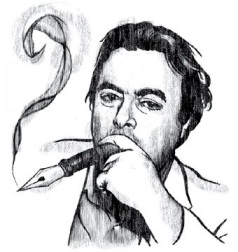
Hitchens by Michael Hogue
Hitch, lives a life well examined with appalling writing skill, with a mesmerizing oratory and with a dare rejection of any celestial and worldly tyranny. He loves to read, to write, and to debate. Of course, whiskey accompanied him in his table, and a roll of tobacco feels comfortable in his left hand. His right hand is always on duty, a sacred duty —Writing.
He loves Orwell. Religion was his number one enemy. Even the gods feared him. He is one of the few who will be remembered in the posterity. Of the many of his precious gifts, here are six of them.
Arguably: Selected essays
Hitch-22, A Memoir
The Missionary Position: Mother Theresa in Theory and Practice
God is Not Great: How Religion poisons everything
The Portable Atheist: Essential readings

